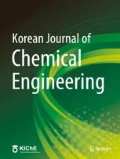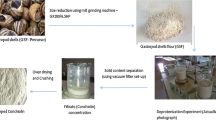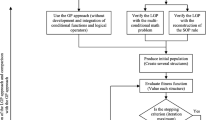Abstract
In this research, genetic programming and multivariate statistical analysis techniques have been applied for decision support on the coagulant dosage and the mixing ratio as two kinds of coagulants have been injected at the same time in the coagulating sedimentation process of water treatment. The coagulant dosage has typically been determined through the Jar-test, which requires a long experiment time in a field-water treatment plant. It is difficult to efficiently determine the coagulant dosage since water quality changes with time. As there are no human experts who have sufficient knowledge and experience in the field, coagulants may be injected with an improper mixing ratio, which causes poor performance in the coagulating sedimentation process. In this study, a model for the approximation of coagulant dosage has been developed using genetic programming (GP). The performance of this model was evaluated through validation. A guideline on the optimal mixing ratio between PACS (Poly Aluminum Chloride Silicate) and PAC (Poly Aluminum Chloride) has been provided through statistical analysis.
Similar content being viewed by others
References
S.H. Kim and J.Y. Yoon, J. Wat. Suppl.: Res. & Technol.-AQUA, 54, 95 (2005).
L. Lu, H. Ratnaweera and O. Lindholm, VATTEN, 59, 227 (2003).
Y. Zhan, China Water and Wastewater, 20, 55 (2004).
H. Bae, S. Kim and Y. Kim, Lecture Notes in Computer Science, Springer-Verlag GmbH, 3735, 371 (2005).
Y. Kim, Ph. D. Thesis, Pusan National University, Busan (2006).
X. Cai, D. C. McKinney and L. S. Lasdon, Advances in Water Resources, 24, 667 (2001).
J.H. Cho, K. S. Sung and S. R. Ha, J. of Environmental Management, 73, 229 (2004).
L.M. Deschaine, J. McCormack, D. Pyle and F. Francone, PC AI, 15, 35 (2001).
J. R. Koza, in Genetic programming: On the programming of computers by means of natural selection, MA: The MIT Press, Cambridge (1992).
M. Walker, in Introduction to genetic programming, Technical report (2001). http://www.rmltech.com
J.-B. Serodes, M. J. Rodriguez and A. Ponton, Environmental Modelling and Software, 16, 53 (2001).
Author information
Authors and Affiliations
Corresponding author
Rights and permissions
About this article
Cite this article
Park, S., Bae, H. & Kim, C. Decision model for coagulant dosage using genetic programming and multivariate statistical analysis for coagulation/flocculation at water treatment process. Korean J. Chem. Eng. 25, 1372–1376 (2008). https://doi.org/10.1007/s11814-008-0225-9
Received:
Accepted:
Published:
Issue Date:
DOI: https://doi.org/10.1007/s11814-008-0225-9




